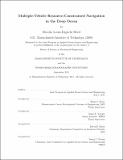| dc.contributor.advisor | Franz S. Hover and Dana R. Yoerger. | en_US |
| dc.contributor.author | Reed, Brooks Louis-Kiguchi | en_US |
| dc.contributor.other | Woods Hole Oceanographic Institution. | en_US |
| dc.date.accessioned | 2012-01-31T14:35:53Z | |
| dc.date.available | 2012-01-31T14:35:53Z | |
| dc.date.copyright | 2011 | en_US |
| dc.date.issued | 2011 | en_US |
| dc.identifier.uri | http://hdl.handle.net/1721.1/68997 | |
| dc.description | Thesis (S.M.)--Joint Program in Applied Ocean Science and Engineering (Massachusetts Institute of Technology, Dept. of Mechanical Engineering; and the Woods Hole Oceanographic Institution), 2011. | en_US |
| dc.description | This electronic version was submitted by the student author. The certified thesis is available in the Institute Archives and Special Collections. | en_US |
| dc.description | Cataloged from student submitted PDF version of thesis. | en_US |
| dc.description | Includes bibliographical references (p. 139-148). | en_US |
| dc.description.abstract | This thesis discusses sensor management methods for multiple-vehicle fleets of autonomous underwater vehicles, which will allow for more efficient and capable infrastructure in marine science, industry, and naval applications. Navigation for fleets of vehicles in the ocean presents a large challenge, as GPS is not available underwater and dead-reckoning based on inertial or bottom-lock methods can require expensive sensors and suffers from drift. Due to zero drift, acoustic navigation methods are attractive as replacements or supplements to dead-reckoning, and centralized systems such as an Ultra-Short Baseline Sonar (USBL) allow for small and economical components onboard the individual vehicles. Motivated by subsea equipment delivery, we present model-scale proof-of-concept experimental pool tests of a prototype Vertical Glider Robot (VGR), a vehicle designed for such a system. Due to fundamental physical limitations of the underwater acoustic channel, a sensor such as the USBL is limited in its ability to track multiple targets-at best a small subset of the entire fleet may be observed at once, at a low update rate. Navigation updates are thus a limited resource and must be efficiently allocated amongst the fleet in a manner that balances the exploration versus exploitation tradeoff. The multiple vehicle tracking problem is formulated in the Restless Multi-Armed Bandit structure following the approach of Whittle in [108], and we investigate in detail the Restless Bandit Kalman Filters priority index algorithm given by Le Ny et al. in [71]. We compare round-robin and greedy heuristic approaches with the Restless Bandit approach in computational experiments. For the subsea equipment delivery example of homogeneous vehicles with depth-varying parameters, a suboptimal quasi-static approximation of the index algorithm balances low landing error with safety and robustness. For infinite-horizon tracking of systems with linear time-invariant parameters, the index algorithm is optimal and provides benefits of up to 40% over the greedy heuristic for heterogeneous vehicle fleets. The index algorithm can match the performance of the greedy heuristic for short horizons, and offers the greatest improvement for long missions, when the infinite-horizon assumption is reasonably met. | en_US |
| dc.description.statementofresponsibility | by Brooks Louis-Kiguchi Reed. | en_US |
| dc.format.extent | 148 p. | en_US |
| dc.language.iso | eng | en_US |
| dc.publisher | Massachusetts Institute of Technology | en_US |
| dc.rights | M.I.T. theses are protected by
copyright. They may be viewed from this source for any purpose, but
reproduction or distribution in any format is prohibited without written
permission. See provided URL for inquiries about permission. | en_US |
| dc.rights.uri | http://dspace.mit.edu/handle/1721.1/7582 | en_US |
| dc.subject | Joint Program in Applied Ocean Science and Engineering. | en_US |
| dc.subject | Mechanical Engineering. | en_US |
| dc.subject | Woods Hole Oceanographic Institution. | en_US |
| dc.subject.lcsh | Navigation Research | en_US |
| dc.subject.lcsh | Oceanographic instruments | en_US |
| dc.title | Multiple-vehicle resource-constrained navigation in the deep ocean | en_US |
| dc.type | Thesis | en_US |
| dc.description.degree | S.M. | en_US |
| dc.contributor.department | Joint Program in Applied Ocean Physics and Engineering | en_US |
| dc.contributor.department | Woods Hole Oceanographic Institution | en_US |
| dc.contributor.department | Massachusetts Institute of Technology. Department of Mechanical Engineering | |
| dc.identifier.oclc | 773826927 | en_US |
